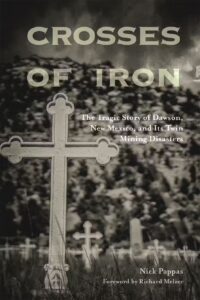SUBSCRIBE!
for updates to my blog
and to my events schedule
Dawson forever linked to Experimental Mine’s groundbreaking history

Industrial history was made yesterday at Bruceton.
So began a front-page story in The Pittsburgh Post on Oct. 31, 1911, describing in painstaking detail the first public demonstration inside the U.S. government’s new Experimental Mine in Bruceton, Pennsylvania.
Its purpose?
To determine once and for all whether coal dust – in a mine absent of dangerous gases – could be responsible for explosions that had plagued the U.S. mining industry since at least the 1880s.
And Dawson, New Mexico, played a prominent role on this historic day.
Miner safety
On May 16, 1910, Congress authorized the creation of the U.S. Bureau of Mines under the Department of the Interior. The legislation, which took effect July 1, was prompted by a surge in miner fatalities in 1907, capped by two December mine explosions in West Virginia and Pennsylvania that claimed the lives of 601 men between them. Overall, a record 3,242 miners were killed that year.
The new agency was charged with making a “diligent investigation” into mining practices, particularly those related to miner safety. This included research into permissible explosives and electricity inside the mines.
How best to carry out that mission?
By conducting scientific research inside an actual mine.
After some difficulty finding a suitable site, the bureau leased a 38-acre parcel from the Pittsburgh Coal Co. near Bruceton, Pennsylvania, 13 miles southwest of Pittsburgh. Development of the Experimental Mine, one of the few such testing sites in the world, began in December 1910.
By October 1911, when preliminary testing began, the U.S. government mine consisted of two parallel entries measuring roughly 700 feet long and 9 feet wide. The tunnels were separated by a 41-foot pillar of coal with crosscuts every 200 feet.
On the surface, no expense was spared to create a de facto coal camp, albeit one with an explosion gallery, observatory, and control station with recording instruments.
‘The roar was deafening’
The Bureau of Mines, under the direction of Joseph A. Holmes, scheduled the first public demonstration of its new mine for Oct. 30, 1911, part of a two-day extravaganza dedicated to mine safety. On this rainy Monday, more than 1,500 people turned out to tour the mine and witness what would happen when 9 pounds of black powder ignited 852 pounds of coal dust spread across 600 feet of the main entry.
To reflect real-life conditions, the powder was packed to replicate several blown-out shots, an all-too-common occurrence in mines where the force of the explosion extends outward rather than inward to dislodge the coal.
After two failed attempts blamed on short circuits in the firing line, presumably caused by visitors inadvertently stomping over wires during the tour, the powder ignited at 6:30 p.m.
Did it ever.
“Suddenly, the sky was lighted before them,” the Pittsburgh Press reported in breathtaking prose. “Sparks climbed among the branches of the tall oak trees above the entrances of the mine and showered in midair like the bursting of a rocket. The roar was deafening. The ground beneath the crowd’s feet quivered. The leaves were emptied of rain drops that fell in a shower on the already drenched spectators. A big cloud of smoke, blacker than the night, rolled from the mouths of the mine, settling back on the earth with the odor of gases in its mantle.”
The force of the blast was felt 4 miles away, the bureau would report later, the noise heard 12 miles from the blast site.
After the demonstration, two teams of rescue men rushed into the mine to test their skills. One team of 10 included six men from the Colorado Fuel & Iron Co. The other seven-member team consisted entirely of Dawson miners, according to newspaper reports.
Dawson also was represented the next day when an estimated 15,000 people attended a first-aid demonstration at nearby Forbes Field, the home of the Pittsburgh Pirates baseball team. President William H. Taft attended the event, handing out American Red Cross medals and first-aid packages to the captains of 40 teams – including one from Dawson – according to Scientific American magazine.
‘A great lesson’
For Holmes, considered by his peers the “founding father of modern mine safety,” the previous day’s demonstration at the Experimental Mine put to rest any lingering skepticism about the explosive properties of coal dust.
“The great value of this experiment to the mining industry was in demonstrating to more than 1,500 people from every coal mining district of the United States the fact that ordinary bituminous or soft coal dust will explode from a charge of black powder badly placed in a mine; and that poisonous gases are given off from such an explosion in sufficient quantities to suffocate and poison any person in the mine,” said Holmes, who had the honor of triggering the blast.
“No amount of writing or talking could be so forcible in the teaching of such a great lesson.”
Sadly, as Dawsonites know all too well, that lesson didn’t put an end to coal dust explosions inside American mines.
Two years later, on Oct. 22, 1913, coal dust would be identified as a key factor in a Dawson explosion that claimed the lives of 263 men, the nation’s second-deadliest mine disaster on record. Coal dust also would be cited a decade later in another Dawson blast that killed 120 miners.
Crosses of Iron
by Nick Pappas
Now available to order from:
University of New Mexico Press
… and other booksellers.
Audiobook version available to order from …
… and other audiobook sellers.

